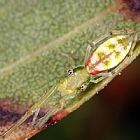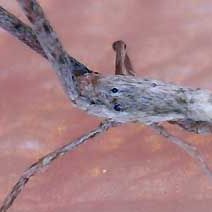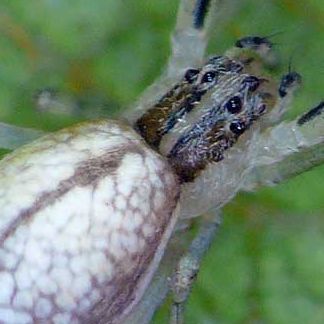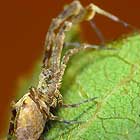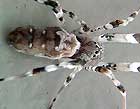Uloboridae is the only spider family without venom. They are usually very small, widespread, diverse and common, especially around houses, but they can also be amongst the most numerous spiders in foliage, where they spin small orb webs.They have air sensitive hairs, a silk producing plate and a calamistrum, which is a comb for reefing out this silk. Cribellate silk (sometimes called hackled silk) is feathery and rather fuzzy. The front legs of the Uloborids are generally long, often longer than the entire length of the body. There are two subfamilies, the Uloborinae and the Miagrammopinae (whose webs are reduced to a single strand). The Miagrammopinae are found mostly in well-forested areas and have only 4 eyes. The introduced Zosis geniculatus is common in houses on ceilings, under eaves, under the house and in garages or sheds. It can be identified by its banded knees and pink, ninja-star-style egg sacs.
Miagrammopes > Colourful Miagrammopes
A colourful small Miagrammopes species. 
Miagrammopes sp Extra long Miagrammopes
This spider was collected mid August 2009 on the northern side of the junction of Fish and Enoggera Creeks, Walton Bridge Reserve, The Gap. Body length: 4.5mm. The very thin and long body and first legs extended forwards are characteristic of this genus. 
Miagrammopes sp Green Rainforest Miagrammopes
A slender and attractively coloured Uloborid quite common in the rainforest at Mount Glorious. These are cribellate spiders, meaning they have a cribellum to produce woolly silk which they comb out with the help of the calimustrum. Like some other spiders they resemble a terrestrial squid. 
Miagrammopes species
This Miagrammopes species may be undescribed. It is a small, but fairly common Uloborid in South East Queensland, females to 5mm in body length, males up to 4mm. It is found in bushland and adjoining suburban parks and gardens. It is off-white to grey or buff-cream coloured with orange... 
Philoponella congregabilis Rainbow 1916 Communal Philoponella
Philoponella congregabilis, previously Uloborus congregabilis is a common Uloborid spider on Australia's east coast. The body can be light grey, cream, orange to chocolate brown, sometimes black, females with a body length up to 6mm, males up to 3.5mm. The female usually has a large and prominent hump with two pointy knobs (tubercles), the male having 4 tubercles. As the name suggests it is usually found in close knit communities... 
Philoponella sp Smooth Philoponella
A small Philoponella, probably undescribed, relatively common in grassy areas on rainforest margins in SE Queensland. Female body length 3-4mm, the male 2-3mm. 
Philoponella variabilis? Variable Philoponella
Like all Uloboridae, this species has no venom. They are common in Brisbane gardens but often unnoticed due to their small size. Various specimens are shown here, from different locations. The are all 2-4mm body length. Adult males and females, both with body length about 3-4mm, can sometimes... 
Uloborus barbipes L. Koch, 1872 Tufted Uloborus
Collected on the creek near the SOWN shed, Paten Park in mid August 2009. Body lenth about 4mm with the front legs as long again, if not longer. 
Zosis geniculatus (Grey House Spider)
Zosis geniculatus is common and easy to recognise. As it is venomless it is a harmless method of controlling insects in your house. It creates a ragged blue grey circular web, with star shaped egg sacs. Insects trapped in the web are rolled with the hind legs and wrapped in silk. The bundle is eventually carried to the hub of the web and sucked dry. 
